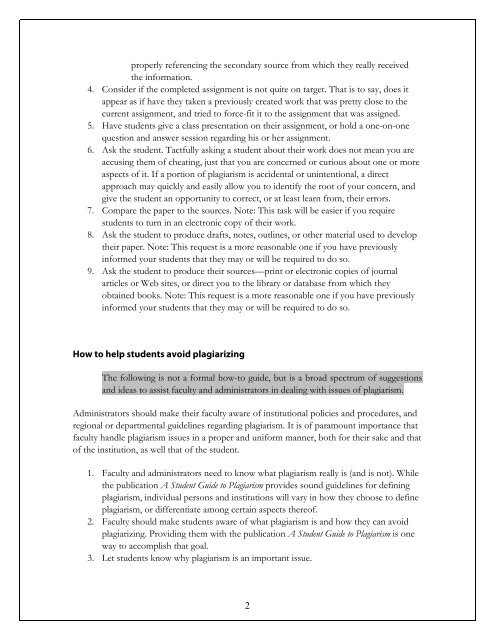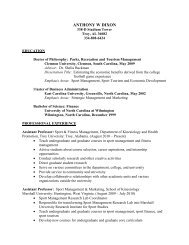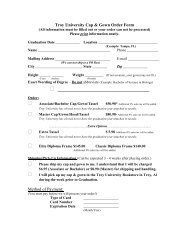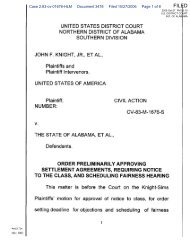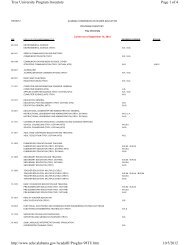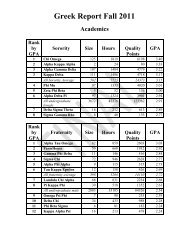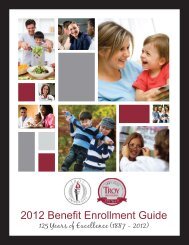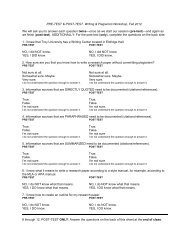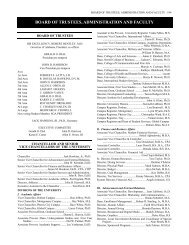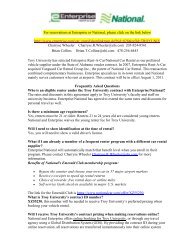A faculty guide to plagiarism - Troy University
A faculty guide to plagiarism - Troy University
A faculty guide to plagiarism - Troy University
- No tags were found...
You also want an ePaper? Increase the reach of your titles
YUMPU automatically turns print PDFs into web optimized ePapers that Google loves.
properly referencing the secondary source from which they really receivedthe information.4. Consider if the completed assignment is not quite on target. That is <strong>to</strong> say, does itappear as if have they taken a previously created work that was pretty close <strong>to</strong> thecurrent assignment, and tried <strong>to</strong> force-fit it <strong>to</strong> the assignment that was assigned.5. Have students give a class presentation on their assignment, or hold a one-on-onequestion and answer session regarding his or her assignment.6. Ask the student. Tactfully asking a student about their work does not mean you areaccusing them of cheating, just that you are concerned or curious about one or moreaspects of it. If a portion of <strong>plagiarism</strong> is accidental or unintentional, a directapproach may quickly and easily allow you <strong>to</strong> identify the root of your concern, andgive the student an opportunity <strong>to</strong> correct, or at least learn from, their errors.7. Compare the paper <strong>to</strong> the sources. Note: This task will be easier if you requirestudents <strong>to</strong> turn in an electronic copy of their work.8. Ask the student <strong>to</strong> produce drafts, notes, outlines, or other material used <strong>to</strong> developtheir paper. Note: This request is a more reasonable one if you have previouslyinformed your students that they may or will be required <strong>to</strong> do so.9. Ask the student <strong>to</strong> produce their sources—print or electronic copies of journalarticles or Web sites, or direct you <strong>to</strong> the library or database from which theyobtained books. Note: This request is a more reasonable one if you have previouslyinformed your students that they may or will be required <strong>to</strong> do so.How <strong>to</strong> help students avoid plagiarizingThe following is not a formal how-<strong>to</strong> <strong>guide</strong>, but is a broad spectrum of suggestionsand ideas <strong>to</strong> assist <strong>faculty</strong> and administra<strong>to</strong>rs in dealing with issues of <strong>plagiarism</strong>.Administra<strong>to</strong>rs should make their <strong>faculty</strong> aware of institutional policies and procedures, andregional or departmental <strong>guide</strong>lines regarding <strong>plagiarism</strong>. It is of paramount importance that<strong>faculty</strong> handle <strong>plagiarism</strong> issues in a proper and uniform manner, both for their sake and tha<strong>to</strong>f the institution, as well that of the student.1. Faculty and administra<strong>to</strong>rs need <strong>to</strong> know what <strong>plagiarism</strong> really is (and is not). Whilethe publication A Student Guide <strong>to</strong> Plagiarism provides sound <strong>guide</strong>lines for defining<strong>plagiarism</strong>, individual persons and institutions will vary in how they choose <strong>to</strong> define<strong>plagiarism</strong>, or differentiate among certain aspects thereof.2. Faculty should make students aware of what <strong>plagiarism</strong> is and how they can avoidplagiarizing. Providing them with the publication A Student Guide <strong>to</strong> Plagiarism is oneway <strong>to</strong> accomplish that goal.3. Let students know why <strong>plagiarism</strong> is an important issue.2


